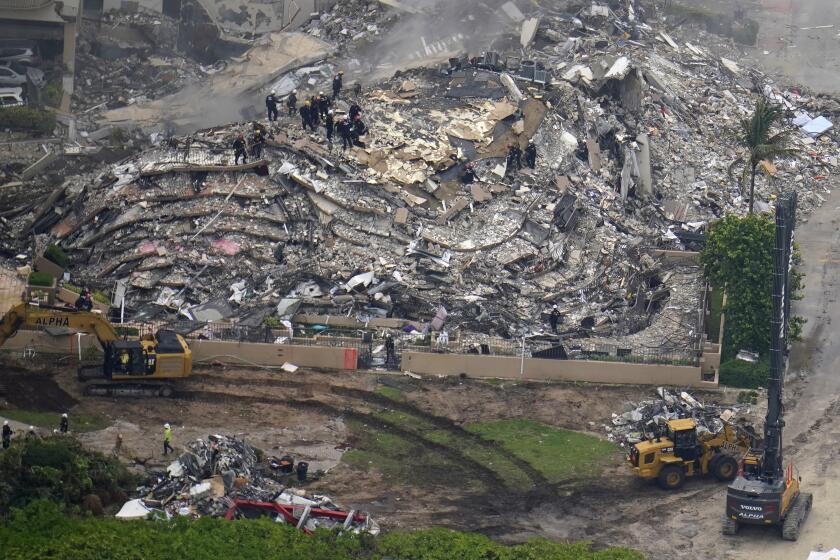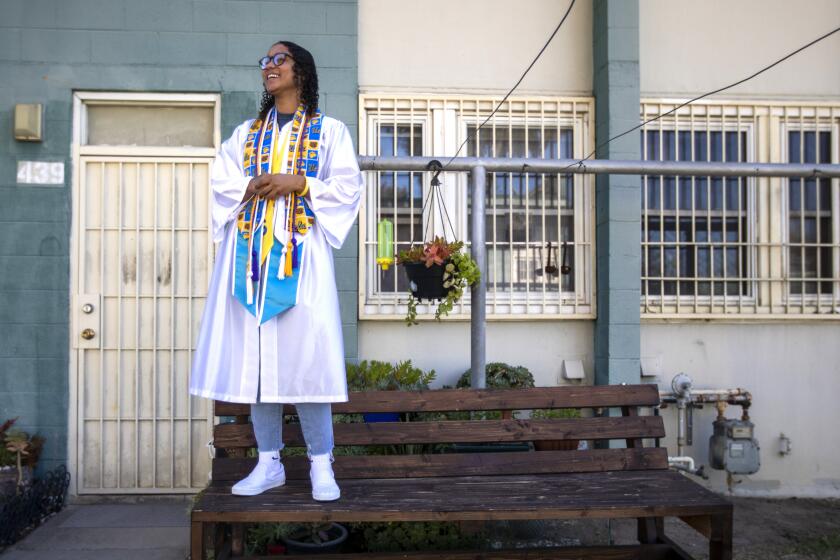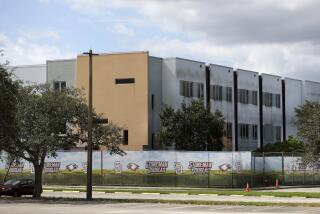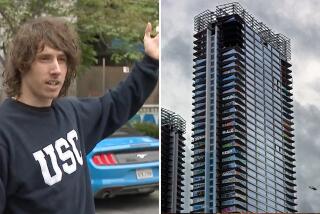Those missing in Florida condo collapse were a diverse group, straddling cultures, countries, generations and faiths
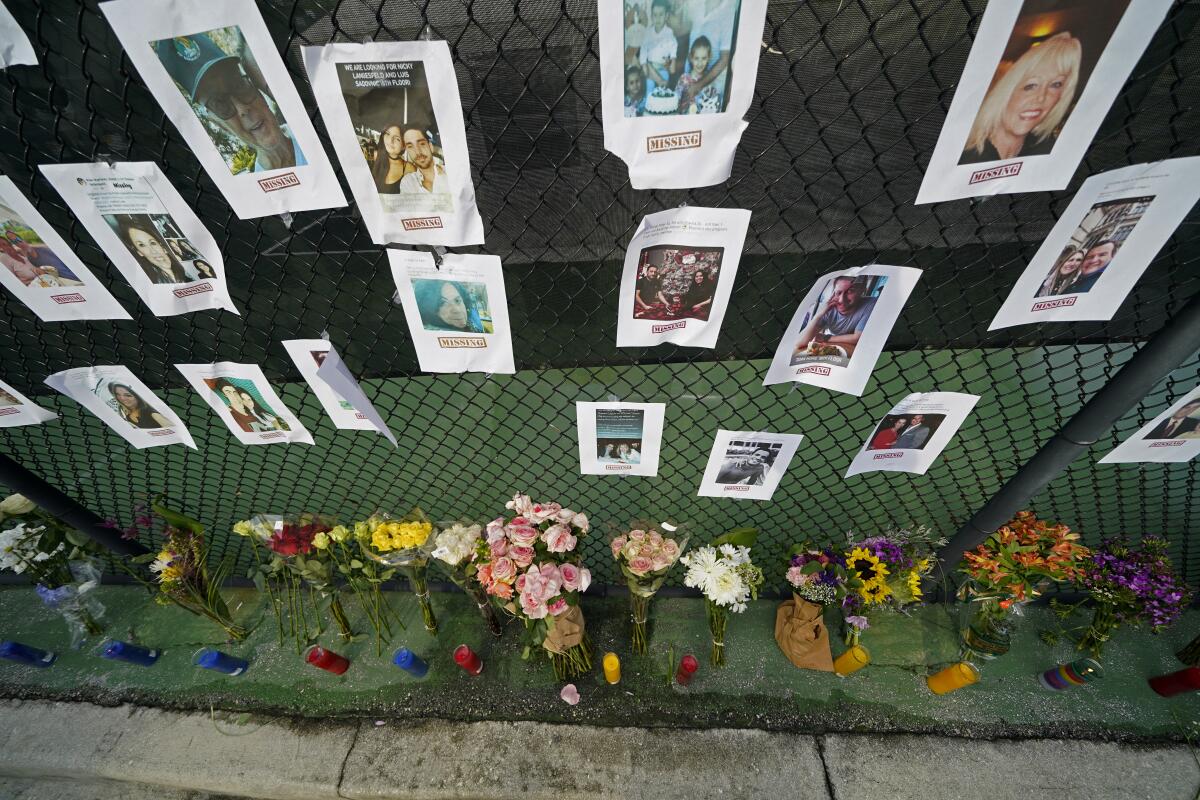
- Share via
SURFSIDE, Fla. — On the ninth floor, Magaly Delgado, 80, a devout Catholic from Cuba with a love for lobster and Elvis Presley, was looking forward to traveling to Napa, Calif.
Seven floors below, Chaim “Harry” Rosenberg, a 52-year-old asset manager from Brooklyn who is Jewish, was thrilled to host his daughter, Malki, and her husband, Benny, from New Jersey. He had bought the apartment just a few months ago, and hoped the sweeping views of the Atlantic Ocean would help clear his mind after losing his wife to brain cancer and both parents to COVID-19.
Leidy Vanessa Luna Villalba, 23, a nanny from rural Paraguay, had arrived on Wednesday with the sister of Paraguay’s first lady. It was her first trip abroad and she messaged her family on WhatsApp that she could not wait to explore the city and go to the beach.
The people inside Champlain Towers South, a 12-story beachfront condo complex just north of Miami Beach, reflected Miami’s status as a staggeringly diverse, international 21st century metropolis, one that draws a unique mix of wealthy South American immigrants and tourists, Orthodox Jews and sun-chasing retirees from the Northeast.
The luxury mid-rise tower’s sudden and dramatic collapse at 1:30 a.m. Thursday plunged families across the United States and Latin America into a surreal nightmare.
Without warning, about half of the complex’s 136 units crashed to the ground. Days later, nine residents were known dead but more than 150 possible victims remained unaccounted for. Search and rescue crews continued to work through Sunday to probe the 30-foot mountain of concrete and metal for lingering signs of life.
Rescuers were using infrared technology, water and foam to battle the blaze. Its source was unclear.
“You just want to jump on the rubble,” a relative of Maggie Vasquez-Bello, one of the missing, said as she sat on the golden sand below the collapsed tower, clutching a rosary. The relative asked not to be identified.
While the cause of the collapse has yet to be determined, Surfside officials released a 2018 report late Friday in which an engineer flagged that the building had a “major error” where lack of drainage on the pool deck had caused “major structural damage” to a concrete slab below that deck.
According to engineering and architectural experts, multiple factors could have played a role in the tragedy: saltwater corroding the concrete and weakening support beams, a compromised foundation or flaws in the building’s design or construction.
The building, which had not completed its required 40-year recertification, was in the process of having work done on its roof and about to undergo extensive repairs for rusted steel and damaged concrete.
On Saturday, half of the tower looked like a dollhouse, exposing an empty children’s bunk bed and a desk chair and cabinet in a penthouse apartment. The other half — including the apartment Vasquez-Bello had been in — was a massive mound of metal and concrete. A mother of five from the suburban city of Pinecrest about 25 miles to the southwest, Vasquez-Bello had been taking an overnight break with two girlfriends.
“We’re trusting in the power of the Lord,” her relative said as waves of white foam crashed onto the shore.
Across Surfside, Jewish and Catholic community members gathered on street corners and in frontyards, inside synagogues and on the beach to form prayer circles and read psalms.
“I believe in God’s grace and in God’s miracles and in the power of prayer,” Magaly Ramsey, 57, said as she stood outside a family reunification center holding up a photo of her mom, Magaly Delgado, on her cellphone.
On Wednesday, Ramsey was at a work conference in Orlando and didn’t pick up a call from her mother. On Thursday morning, her return calls went straight to voicemail.
“The worst thing is not knowing,” said Ramsey.
Pilar Diaz Bombino made the long journey from Havana to Watts. Her next stop is UCLA.
Wedged just north of Miami Beach and south of the glitzy mall and skyscrapers of Bal Harbour, Surfside is a tiny multicultural city, population 5,600, a place where conversations flit from Spanish to English to Hebrew, and local stores offer kosher sushi, fresh-baked challah and empanadas stuffed with beef and green olives.
The vibe is, for the most part, easygoing as tanned women in bright bikinis sashay down the palm-tree-lined streets past Hasidic Jews rushing to synagogue in long dresses and headscarves.
The usual summer scenes — a middle-aged man in Speedos dipping his feet in the Atlantic and kids strolling the promenade with frozen yogurt — seemed jarring as smoke billowed in the background from the rubble and rescue teams picked their way through the debris.
Some of the apartments in the building had recently sold for more than $1 million, but the complex was not as upscale as more recent builds.
Last year, construction finished on a curved glass and steel 18-story high-rise designed by Pritzker Prize-winning architect Renzo Piano in a neighboring lot in North Beach. One apartment in that building went for $6 million.
Surfside, a modest seaside town of mostly one- and two-story buildings, has largely eschewed the excesses of the towering high-rises of neighboring Bal Harbour, an internationally renowned shopping destination with Alexander McQueen, Chanel and Gucci stores, and Sunny Isles Beach, home to Trump Tower. The city’s maximum building height is 12 stories.
With the city balancing a tightrope between small tight-knit community and tropical vacation destination, the Champlain Towers South was home to longtime Surfside residents, including Arnie Notkin, 87, a much-loved Jewish P.E. teacher and coach at a local elementary school, and his wife, Myriam Caspi Notkin, 81, who is Cuban. Claudio Bonnefoy Bachelet, a cousin of the father of former Chilean President Michelle Bachelet, lived in unit 1001 for more than a decade with his wife, Maricoy Obias-Bonnefoy, a Filipina immigrant who had retired as a senior budget officer for the International Monetary Fund in Washington, D.C.
Others were just touching down for a short trip. Andres Galfrascoli, a well-known plastic surgeon from Argentina, had borrowed a friend’s apartment with his theater director husband, Fabián Nuñez, and their daughter, Sofía, while getting a COVID-19 vaccination.
The Miami Beach area has long been a haven for Jewish retirees from the Northeast, and in 1959 the first wave of Jews from Cuba fled to Miami when Fidel Castro took power, but in recent decades a growing number of Latin American Jewish immigrants and tourists from Venezuela, Colombia, Argentina, Mexico and Peru have snapped up second homes or settled in the area.
Some settled in the Champlain Towers, constructed in 1980 and fringed by palm and sea grape trees while boasting a heated swimming pool, valet parking, sauna and tennis courts.
In 1980, an advertisement in the Miami Herald boasted “elegant condominium residences” with one-bedrooms starting from $148,000.
“Be the first to get the best of the last,” the ad said.
Almost a third of those reported missing were foreign nationals, according to Sen. Marco Rubio (R-Fla.). After officials worked to expedite emergency visas for people from more than a dozen countries who have close relatives missing, Rubio said on Twitter that by Friday evening many had already arrived in south Florida or were en route.
Many people were furious and frustrated that more had not been done to extract their loved ones from the rubble.
Soriya Cohen, a Surfside resident who grew up in New York, questioned the pace of authorities in trying to find her husband, Brad, 51, a Miami orthopedic surgeon. He was missing after staying at their 11th-floor apartment with his brother, who was visiting from Alabama.
Why, she asked, did search and rescue teams not have more dogs or boots on the ground? Could they not chant into bullhorns to motivate her husband and other potential survivors to keep fighting?
“This could be the difference between life and death,” she said. “I feel like I’m living in a Third World country and they just don’t care enough. The will to live is so strong. I want them to know we are all rooting for them.”
Maurice Wachsmann, 50, was also frustrated and questioned why the body of his friend and more than 150 missing were apparently still under the rubble.
His best friend, Harry Rosenberg, he said, was “a man with a heart of gold who would do anything for anybody.”
Like many Champlain Towers residents, Rosenberg attended the Shul of Bal Harbour, a large Jewish synagogue about a mile north of the condo tower. Wachsmann said he was moved by how the community had come out in force.
“Everybody’s here for each other,” he said as a steady stream of locals dropped off water bottles, blankets, first aid kits, wipes and battery chargers for the surviving residents at the Surfside Community Center.
Dozens were rescued and a teenage boy was pulled from the rubble. Half the building remained relatively intact, so many were able to clamber out themselves or were helped to safety. According to officials, 130 inhabitants were accounted for by Saturday.
A Cuban woman weaved carefully through volunteers holding a tray loaded with pastries, stopping to pass out tiny cups of cafecitos and guava pastelitos, as Jewish volunteers handed out hot kosher meals of ribeye steak, falafel and pita bread.
“How could you not come out?” said Joseph Zevuloni, a Jewish businessman from Broward County who was helping to dole out hundreds of hot meals.
Hours after the tower collapsed on Thursday, he said, he had talked to a 12-year-old girl as she sat in a corner crying. She told him she was waiting for her father.
“You give food, you give people the feeling someone cares,” he said.
As officials announced Saturday night they had pulled the fifth body and some additional human remains out of the rubble, hopes were fading across the community that more of the missing would be discovered alive.
More to Read
Sign up for Essential California
The most important California stories and recommendations in your inbox every morning.
You may occasionally receive promotional content from the Los Angeles Times.
